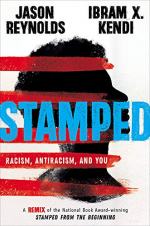
|
| Name: _________________________ | Period: ___________________ |
This test consists of 15 multiple choice questions and 5 short answer questions.
Multiple Choice Questions
1. What period of time did uplift suasion seem to be working as intended in?
(a) The 1920s.
(b) The 1850s.
(c) The 1950s.
(d) The 1790s.
2. What does Kendi say is the first step to building an antiracist America?
(a) Understanding how Harvard University was founded.
(b) Acknowledging America's racist past.
(c) Reading the writings of Von Nuremburg.
(d) Reading the writings of Aristotle.
3. When did Thomas Jefferson die?
(a) July 2, 1850.
(b) July 4, 1890.
(c) July 4, 1826.
(d) May 8, 1843.
4. What did the Puritans stipulate at the opening of the first U.S. university?
(a) All the professors had to be priests.
(b) Greek and Latin texts could not be disputed.
(c) Blacks were allowed to attend as long as they worked at the university, too.
(d) Women were allowed to attend, but only in small numbers.
5. How did the world's first racist depict Africans in his book, according to Reynolds and Kendi?
(a) As people who were physically well-suited for work.
(b) As lazy people who needed to be instilled with a better work ethic.
(c) As savages that needed training.
(d) As lost souls who could be rehabilitated.
6. What did the Climate Theory say about Africans?
(a) They were savages because of the cold climate they came from.
(b) They were redeemable because of the churches in their homelands.
(c) They would only be able to work in places with similar climates to where they grew up.
(d) They were savages because of the hot weather where they came from.
7. Which of the following ideas did Jefferson promote in the late 1700s?
(a) Slaves should be freed after the next two decades.
(b) All slaves deserved freedom except for the ones he owned.
(c) Slaves should be sent back to Africa.
(d) The northern states had a responsibility to fight against slavery.
8. What did writer John Locke believe about Blacks?
(a) They were better musicians than whites.
(b) They had less agile and developed minds than Whites.
(c) They were more violent than Whites.
(d) They had better physical health than Whites.
9. What do Reynolds and Kendi say Thomas Jefferson might have been the first White person to say?
(a) I have Black friends.
(b) I have White friends.
(c) I am not a racist, but.
(d) I am the least racist person you know.
10. Which formerly enslaved woman wrote an antislavery book?
(a) Harriet Tubman.
(b) Joan Bent.
(c) Micheline Maynor.
(d) Sojourner Truth.
11. Chapter 7 consists of one sentence that says Africans are NOT which of the following?
(a) Examples.
(b) Humans.
(c) Inspirations.
(d) Savages.
12. Which politician's rise came shortly after the publication of Uncle Tom's Cabin?
(a) Abraham Lincoln.
(b) Andrew Jackson.
(c) James Monroe.
(d) Woodrow Wilson.
13. Who did the world's first racist write a biography about, according to Reynolds and Kendi?
(a) Hippocrates.
(b) King Harold.
(c) Jesus.
(d) Prince Henry.
14. Which of the following books did Thomas Jefferson write?
(a) The Real History of Paul Revere's Ride.
(b) Notes on the State of Virginia.
(c) Independence Days.
(d) Handbook for Future Revolutionaries.
15. What was the book that the world's first racist wrote titled, according to Reynolds and Kendi?
(a) Prince Harold's Praise.
(b) Prince Henry's Tome.
(c) The Chronicle of the Discovery and Conquest of Guinea.
(d) Marshall Your Courage.
Short Answer Questions
1. What club did Benjamin Franklin begin in 1743?
2. What book did Cotton Mather write?
3. Who do Reynolds and Kendi claim was the world's first racist?
4. Where did Thomas Jefferson go upon his retirement from public life?
5. Which of the following phrases does Reynolds put forth to the reader that he says his mother would often say?
|
This section contains 616 words (approx. 3 pages at 300 words per page) |

|




